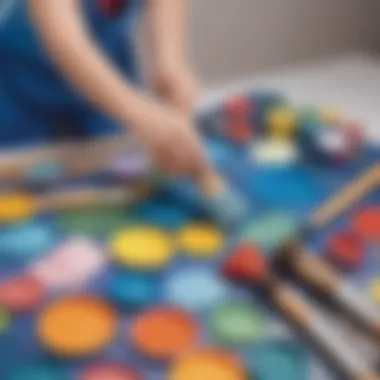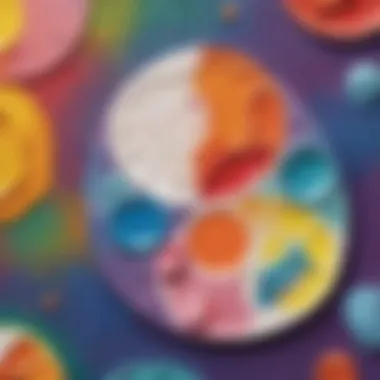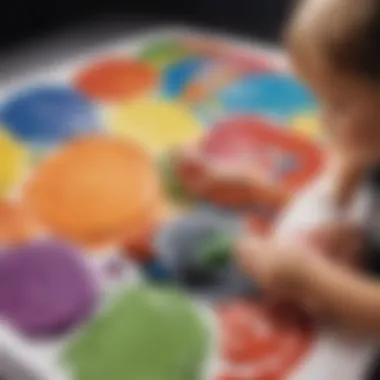Unlocking the Wonders of Foam Sensory Paint for Kids: A Complete Guide


Science Fun Facts
Did you know that foam sensory paint can provide a unique tactile experience for children, engaging multiple senses simultaneously? This tactile stimulation can enhance cognitive development and creativity in young minds, making learning a fun and interactive process. Additionally, foam sensory paint is often used therapeutically to support sensory processing in children with sensory sensitivities, providing a calming and enjoyable sensory experience.
Foam Sensory Paint Benefits and Usage
In this section, we will explore the myriad benefits and versatile usage of foam sensory paint in educational settings. From promoting fine motor skills and hand-eye coordination to stimulating imaginative play and creativity, foam sensory paint offers a wide range of advantages for young learners. Parents, teachers, and caregivers can leverage this innovative tool to foster a child's cognitive development while introducing them to the fascinating world of art and sensory exploration.
Incorporating Foam Sensory Paint in Educational Activities
Discover practical tips and creative ideas for incorporating foam sensory paint into educational activities for children. Whether it's designing sensory-rich art projects, exploring texture through painting, or engaging in sensory play sessions, there are various ways to integrate foam sensory paint into educational settings. By immersing children in hands-on sensory experiences, educators can create a dynamic and engaging learning environment that encourages exploration and discovery.
Conclusion
Introduction to Foam Sensory Paint
Foam sensory paint opens the doorway to a world of creativity and learning for children. This engaging artistic medium not only delights the senses but also enhances cognitive development. Understanding the importance of introducing children to sensory experiences from a young age is vital for their overall growth and learning. Foam sensory paint, with its tactile nature and vibrant colors, offers a unique avenue for children to explore and express themselves. In this article, we will delve deep into the captivating realm of foam sensory paint, shedding light on its myriad benefits, creative applications, and educational value for young learners.
What is Foam Sensory Paint?
Foam sensory paint is a specialized type of paint designed to stimulate multiple senses simultaneously. It typically has a fluffy, airy texture that provides a sensory-rich experience for children as they explore art. This innovative paint variety goes beyond just visual appeal, offering tactile and olfactory stimulation as well. By engaging multiple senses, foam sensory paint can amplify a child's creative exploration and learning journey.
Benefits of Foam Sensory Paint
Encourages Sensory Exploration
Foam sensory paint excels in fostering sensory exploration among children. The unique texture and consistency of this paint type prompt kids to engage their senses actively, from touch to sight and even smell. By encouraging hands-on interaction and sensory investigation, foam sensory paint enhances a child's overall sensory development, making it a popular choice for stimulating artistic experiences.
Boosts Creativity and Imagination
Stimulating creativity and imagination, foam sensory paint opens up a world of possibilities for young artists. Its malleable nature allows children to experiment freely, mixing colors and creating intriguing textures. This freedom to explore helps boost cognitive functions related to creativity and imaginative thinking, making foam sensory paint a valuable tool in nurturing a child's artistic prowess.


Enhances Fine Motor Skills
Another significant benefit of foam sensory paint lies in its ability to improve fine motor skills in children. The hands-on nature of painting with foam encourages the development of hand-eye coordination, precision in movements, and overall dexterity. As children manipulate the paint with various tools and techniques, they refine their motor skills subtly, promoting better control and agility in their artistic endeavors.
Educational Value of Foam Sensory Paint
Promotes Learning Through Play
Foam sensory paint seamlessly integrates learning with play, offering a dynamic educational experience for children. Through hands-on exploration and experimentation, kids not only refine their artistic abilities but also learn concepts such as color mixing, texture recognition, and artistic expression. This fusion of play and learning makes foam sensory paint a valuable asset in encouraging holistic development in young learners.
Provides Hands-On Experience
One of the standout features of foam sensory paint is its emphasis on hands-on learning. By actively engaging in the artistic process, children gain first-hand experience in expressing their creativity, making decisions, and exploring new possibilities. This experiential approach to learning fosters a deeper understanding of artistic concepts and refines critical thinking skills, making foam sensory paint an enriching educational tool for children.
Utilizing Foam Sensory Paint in Educational Settings
Foam sensory paint offers a unique avenue to engage children in educational settings. By incorporating this tactile medium into lesson plans, educators tap into a rich resource for fostering creativity and cognitive development. The key lies in providing a multi-sensory experience that stimulates various aspects of a child's learning process. Whether used in art projects, science experiments, or sensory activities, foam sensory paint opens doors to experiential learning that goes beyond traditional methods.
Incorporating Foam Sensory Paint into Lesson Plans
Art Projects
Art projects are a cornerstone of using foam sensory paint in educational settings. Through art, children can express themselves, develop fine motor skills, and explore different textures and colors. By incorporating foam sensory paint into art projects, educators facilitate not only visual expression but also encourage sensory exploration. The tactile nature of foam paint adds a layer of depth to art activities, enhancing the overall learning experience.
Science Experiments
Integrating foam sensory paint into science experiments can spark curiosity and excitement in children. By incorporating the paint into hands-on experiments, educators can demonstrate scientific concepts in a visual and engaging way. This method not only reinforces learning but also encourages critical thinking and problem-solving skills. The interactive nature of science experiments with foam paint makes complex ideas more accessible and fun for young learners.
Sensory Activities
Sensory activities using foam paint are essential for addressing different learning styles and engaging all senses in the educational process. By incorporating foam sensory paint into sensory activities, educators create opportunities for kinesthetic learners to thrive. These activities promote sensory exploration, develop cognitive skills, and enhance children's spatial awareness. Adding foam sensory paint to sensory play engages children in a holistic learning experience that caters to diverse learning needs.
Enhancing Learning Experiences with Foam Sensory Paint


Interactive Workshops
Interactive workshops provide a dynamic platform for incorporating foam sensory paint into educational settings. These workshops allow children to engage with the material in a hands-on and collaborative environment. By participating in interactive workshops with foam paint, children develop social skills, teamwork, and creative thinking. The immersive nature of these workshops fosters an experiential learning environment that encourages active participation and exploration.
Creative Storytelling Sessions
Creative storytelling sessions that incorporate foam sensory paint offer a unique blend of artistic expression and narrative development. By integrating foam paint into storytelling, educators can enhance children's imagination and language skills. Through storytelling sessions with foam paint, children not only create visual representations of stories but also develop storytelling abilities. This interactive approach to storytelling enriches the learning experience and expands children's creativity and communication skills.
Multisensory Learning Environments
Creating multisensory learning environments with foam sensory paint promotes holistic engagement and comprehensive learning experiences. By integrating foam paint into multisensory activities, educators cater to various learning styles and ensure a well-rounded educational approach. These environments stimulate different senses simultaneously, enhancing children's cognitive development and sensory integration. The dynamic nature of multisensory learning environments with foam paint nurtures creativity, critical thinking, and overall engagement in the educational process.
Creating Homemade Foam Sensory Paint
In this extensive guide exploring foam sensory paint for children, an imperative focus is directed towards creating homemade foam sensory paint. The significance of this section lies in providing parents, teachers, and caregivers with the knowledge and resources to craft safe and stimulating sensory paint for children. By making foam sensory paint at home, individuals can control the ingredients, ensuring they are non-toxic and suitable for young learners. This DIY approach not only promotes creativity but also fosters a sense of ownership in the creative process, enhancing the overall sensory experience for children.
DIY Foam Sensory Paint Recipes
Using Shaving Cream and Glue
Delving into the realm of using shaving cream and glue to concoct foam sensory paint reveals an intriguing facet of this creative endeavor. This particular recipe offers a fluffy and texturally-rich paint that kids enjoy exploring through sensory play. The key characteristic of this method is the simplicity and accessibility of the ingredients. Shaving cream and glue combine to form a paint that is easy to manipulate, providing children with a sensory experience that engages multiple senses. While the popularity of this recipe stems from its affordability and ease of preparation, its unique feature lies in the versatility it offers in creating different textures and finishes in art projects. However, a potential disadvantage may be the slight stickiness of the paint, which requires adequate drying time for optimal results.
Mixing Soap and Food Coloring
Another intriguing concoction for homemade foam sensory paint involves mixing soap and food coloring. This recipe adds a sensory dimension by introducing a scented element to the paint, engaging children's sense of smell along with sight and touch. The key characteristic of this recipe is the incorporation of soap, which not only adds color but also creates a unique texture that can vary based on the type of soap used. The appeal of this recipe lies in the vibrant colors achieved through food coloring, enhancing the visual aspect of sensory exploration. However, a consideration to make is the scent of the soap, which may not be appealing to all children. Thus, selecting a mild and child-friendly soap is recommended to mitigate any potential drawbacks.
Safety Considerations for Homemade Foam Sensory Paint
Addressing safety concerns when creating foam sensory paint is paramount to ensure children's well-being during sensory play. This section emphasizes the importance of using non-toxic ingredients in paint recipes, safeguarding children from exposure to harmful substances. Non-toxic ingredients not only prioritize children's safety but also provide peace of mind to parents and caregivers, knowing that the paint is harmless if accidentally ingested. However, while non-toxic ingredients are beneficial, it is crucial to supervise children during paint play to prevent any mishaps. Supervised usage ensures that children engage with the paint in a controlled environment, reducing the risk of accidents and encouraging responsible sensory exploration.
Exploration and Creativity with Foam Sensory Paint
Foam Sensory Paint opens a world of exploration and creativity for children, enhancing their sensory experiences through tactile stimulation and artistic expression. By engaging with foam paint, children not only develop their fine motor skills but also explore various textures and colors in a hands-on manner. This section will delve into the significance of encouraging exploration and creativity with foam sensory paint, highlighting the multifaceted benefits and considerations associated with this engaging activity.


Sensory Play Ideas with Foam Paint
The sensory play ideas with foam paint introduce children to a realm of interactive and educational experiences that stimulate their senses and spark imagination. Let's explore three key aspects:
Texture Exploration
Texture exploration involves immersing children in a sensory-rich environment where they can feel and manipulate different textures using foam paint. This sensory play idea allows children to engage their sense of touch, promoting tactile sensitivity and cognitive development. The unique aspect of texture exploration lies in its ability to provide both calming and alerting tactile inputs, offering a versatile sensory experience for children. While texture exploration enhances sensory integration and fine motor skills, its main disadvantage may lie in potential messiness, requiring suitable play environments for optimal enjoyment.
Color Mixing Experiments
Color mixing experiments with foam paint enable children to explore the fascinating world of color blending and creation. Through mixing primary colors, children learn about color theory and enhance their creative skills by experimenting with different shades and hues. This sensory play idea not only fosters artistic expression but also encourages critical thinking as children observe color transformations. The advantage of color mixing experiments lies in promoting experimentation and innovation, encouraging children to explore their creativity through hands-on activities.
Outdoor Art Adventures
Outdoor art adventures with foam paint take artistic exploration beyond the confines of indoor spaces, allowing children to engage with nature and their surroundings creatively. This sensory play idea offers a vibrant and dynamic setting for artistic expression, encouraging children to connect with the environment while expressing themselves through art. The unique feature of outdoor art adventures lies in blending artistic creativity with outdoor exploration, providing a multisensory experience that enriches children's understanding of art and nature. While outdoor art adventures promote outdoor engagement and creativity, they may pose challenges related to weather conditions and space limitations, requiring adaptable outdoor setups for optimal enjoyment.
Artistic Expressions Through Foam Sensory Paint
Artistic expressions through foam sensory paint fuel children's creativity and self-expression, offering a platform for artistic exploration and collaboration. Let's explore two key aspects:
Abstract Art Projects
Abstract art projects with foam paint empower children to explore unconventional forms of expression and creativity. By encouraging abstract thinking and artistic freedom, these projects allow children to unleash their imagination and create art that transcends traditional boundaries. The unique feature of abstract art projects lies in promoting non-representational art, fostering creative interpretation and innovation among children. While abstract art projects encourage artistic experimentation and self-expression, their potential disadvantage may involve varying interpretations and understanding, requiring facilitation to support children's artistic journey.
Collaborative Mural Creations
Collaborative mural creations with foam paint encourage teamwork and cooperation among children, fostering a sense of community and shared creativity. By working together on a unified art piece, children learn the value of collaboration and communication while expressing their individual artistic styles. The key characteristic of collaborative mural creations lies in promoting inclusivity and collective expression, allowing children to contribute to a larger artwork that showcases their diverse perspectives. While collaborative mural creations cultivate social skills and teamwork, they may involve coordination challenges and differing creative visions, requiring positive facilitation to ensure a harmonious artistic process.
Conclusion
In the grand scheme of things, the conclusion of this deep dive into foam sensory paint marks a crucial moment of reflection on the transformative power it holds for children's development and creativity. Exploring the fascinating world of foam sensory paint has illuminated the myriad benefits and possibilities it offers for enhancing learning experiences. By understanding how foam sensory paint stimulates senses and nurtures imagination, parents, teachers, and caregivers gain insight into a valuable tool for educational engagement. The sheer versatility of foam sensory paint in fostering fine motor skills, sensory exploration, and creativity underscores its significance in early childhood development. As we wrap up this comprehensive guide, it is essential to recognize that foam sensory paint transcends mere artistic expression; it becomes a vehicle for holistic learning and growth, paving the way for children to embrace their innate curiosity and expressiveness with boundless possibilities.
Impact of Foam Sensory Paint on Child Development
The impact of foam sensory paint on child development is profound and multifaceted, playing a pivotal role in nurturing various skills and faculties crucial for holistic growth. From a sensory perspective, engaging with foam paint provides a tactile experience that stimulates touch, sight, and even smell, enriching sensory perceptions. This sensory engagement not only enhances cognitive development by promoting sensory exploration but also fosters emotional well-being by encouraging self-expression and creativity. On a cognitive level, manipulating foam paint promotes the development of fine motor skills, hand-eye coordination, and spatial awareness, laying a solid foundation for academic and physical activities. Moreover, the open-ended nature of foam sensory paint allows children to experiment, make choices, and learn from their experiences, fostering independence and problem-solving abilities. In essence, the impact of foam sensory paint transcends mere artistic play; it becomes a potent tool for promoting holistic child development rooted in sensorial engagement, cognitive enhancement, and creative expression.
Encouraging Continued Exploration and Learning
Encouraging continued exploration and learning with foam sensory paint is not just about instilling creativity or fostering skill development; it is about nurturing a lifelong love for learning and discovery. By providing children with opportunities to engage with foam paint in various ways, whether through structured activities or open-ended play, caregivers and educators facilitate a rich learning environment where curiosity thrives. Encouraging exploration through new textures, colors, and techniques stimulates children's natural inclination to inquire, experiment, and problem-solve, fostering a sense of intellectual curiosity and exploration. Furthermore, promoting continuous learning through foam sensory paint cultivates a growth mindset, where mistakes are viewed as learning opportunities and challenges are embraced with resilience and adaptability. By fostering a mindset of exploration and lifelong learning, foam sensory paint becomes not just a creative tool but a symbol of children's endless potential to discover, create, and learn in a world brimming with possibilities.







